Yoga App Development: Case Study-based Guide for Yoga Studios or Startups
Published: February 1, 2024
23 min read
In this article, you'll learn:
1
📈 Trends and Analysis of the Yoga Mobile App Market
2
🧘♀️ Yoga App Users: Their Pain Points and Your Solutions
3
🏬 Why Build an App for a Yoga Studio?
4
👨💻 Why Develop an App for a Yoga Startup?
5
❓ What Types of Yoga Applications Exist?
6
🔎 A Closer Look at the Asana Rebel App
7
📋 The Best Yoga Apps List
8
📱 Top Yoga App Features to Consider
9
⚙️ Tech Stack For Yoga App Development
10
📝 Create a Yoga App in a Few Steps
11
💰 Yoga App Monetization Strategy
12
📚 Case Study: Pocket Yoga, Find What Feels Good
13
💰 Cost to Make a Yoga App
14
💡 Takeaways
Nowadays, yoga has turned from an exotic Brain-Mind-Body practice into one of the most popular well-being routines. When combined with mobile technologies, which is another trend that started in the last decade, it usually results in tremendous success.
Moreover, it looks like the popularity of yoga apps will only grow and get more stable.
If you plan to create a yoga app, you can probably find yourself in one of these 2 categories:
- You’re either a yoga studio owner or teacher (in other words, you have a running business in this wellness industry, either offline or without a user-friendly application) who wants to have more tools to retarget and retain your audience, as well as do it more efficiently. Moreover, you can not only cover your existing customers but reach a much wider audience.
- You’re a Startup Company in this field that doesn’t have any offline yoga-related business but has a unique idea and vision on how to help yoga practitioners with their challenges.
To embark on building your own yoga application, let's first envision typical yoga practitioners, understand their pain points, and explore ways to assist them.
📈 Trends and Analysis of the Yoga Mobile App Market
To begin with, let's delve a bit more into the yoga applications market. According to Gitnux forecasts, the compound annual growth rate (CAGR) of the global yoga market is projected to be 9% from 2023 to 2028, reaching an estimated value of nearly USD 105.9 billion in 2022.
The popularity of online yoga courses is also on the rise. A survey conducted in Japan in 2020 revealed that 40.8% of respondents prefer online yoga due to its convenient participation compared to physically attending classes.

The yoga app, designed with a budget-friendly approach, enhances user experience by offering a seamless interface and a variety of features, allowing users to effortlessly navigate class schedules, track their progress, and customize their yoga journey.
(image by Farhan Fauzan)
In the United States, from 2010 to 2021, the number of Americans practicing yoga at least once a year increased by 63.8%, growing from 21 million to 34.4 million.
These figures indicate a steady and growing yoga market. The increasing popularity of online yoga sessions and applications, initiated during the pandemic, underscores a significant shift towards digital platforms in the yoga industry.
Moreover, the addition of yoga sessions is becoming increasingly popular in the context of corporate wellness app development.
🧘♀️ Yoga App Users: Their Pain Points and Your Solutions
If you want to successfully target those yoga students who have high chances of becoming your paying customers, it’s important to outline their key characteristics. Here they are:
🧘♀️ Typical Yoga Practitioners
Age | Millennials (between 20 and 35 years old) | ||
Sex | More preferred by women but it’s getting more balanced with time. | ||
Paying Ability | Have a stable income & the audience is "ready to buy." | ||
Traits | Healthy lifestyle fans, communicative, social media fans. | ||
What pain points do they have and what solution can you offer them?
Problem ❗️ | How you can help 💡 |
|---|---|
They want to practice yoga at home (for example, because they just don’t have enough time to visit a studio — just like mothers on maternity leave) but need some guidance. | You can offer them yoga video classes that they can either watch online or offline. |
They are about to try yoga for the first time and have no idea how to do it right. | You can use a built-in chat and build a bot to provide users with consultations on different yoga types (for example, how to choose between Iyengar, Ashtanga Vinyasa and Jivamukti), how to make sure the technique is right, etc. |
Offline customers of your yoga studio would like to have more possibilities to interact with your brand online through the chosen mobile platform. | You can let them pay for the club membership, talk to teachers, see the training schedule and play online lessons — all through the app. |
So what are the reasons to develop an app for yoga? Take a look at the reasons below and the answer will appear on its own!
🏬 Why Build an App for a Yoga Studio?
A mobile application can be a powerful enhancement to your business. The best thing about how to build a yoga mobile app for your existing business is that it can be used for both acquiring new customers and retaining existing ones.
Thus, your target might be:
Customers (or potential customers who are considering this opportunity right now) who are looking for a deeper and more personal interaction with your teachers/studio, and people who match your buyer portrait but are located in other cities and regions.
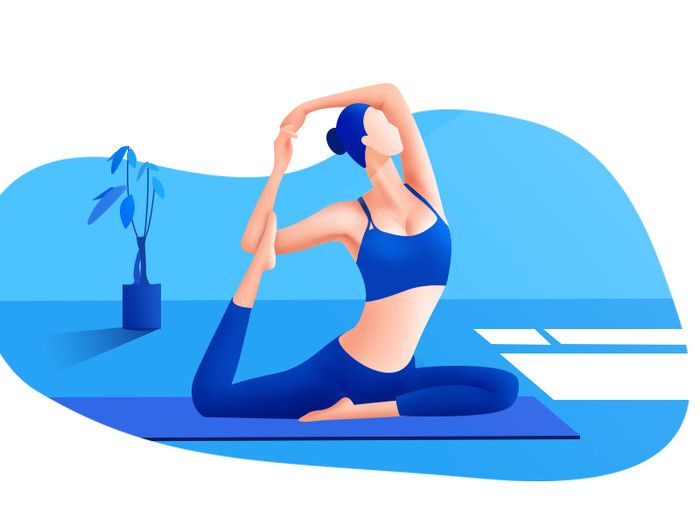
It's important to clearly understand what your mobile audience looks like (image by WANZHI)
Yoga app development services open a new window of opportunities for you: it can make it possible to provide your services with greater flexibility to people who can’t visit your studio physically (for example, because they live in another city) but who are willing to watch your online classes, have an ability to chat with your teachers, etc.
Therefore, the main reasons to create a yoga app for your studio are:
- You will be able to support a more personalized relationship with your customers.
- It is also possible to reach a new audience with your sessions and sell yoga exercise packs not only to people in your region but all over the globe.
- You will have more tools to retain clients.
- Customers will be able to pay for the membership plans online on a recurring basis in just several clicks from their smartphones.
👨💻 Why Develop an App for a Yoga Startup?
Just like for classical businesses, it’s quite reasonable for Startups to create an App. The stats from the Yoga Alliance’s Report prove this idea:
- 98% of yoga practitioners consider their level as beginner-intermediate. Therefore, they need some guidance and assistance — a pain-point that you can target.
- 59% of people who do yoga, practice it at least once a week. It means they’ll have a repeated need in your application.
- Yoga practitioners are usually good-earners, so the audience you are targeting is also a ready-to-pay one. .
- With the deployment of an online and mobile-centric business model, you'll be able to interact with any of your users, any time, from anywhere.
As a Startup, you could target, for example, the following audience:
Individual yoga practitioners of a beginner/intermediate level who do yoga on their own 2 times per week and seek professional guidance and tips.

Mobile Yoga Startups are mostly based on the idea of providing guidance to yoga practitioners (image by Anton Mikhaltsov)
The key challenge here is your USP (Unique Selling Point). In other words, what you’re going to offer your audience, so that you stand out from what your competitors already provide, and why your audience is going to pay for your product.
❓ What Types of Yoga Applications Exist?
Before we tell you how to create a yoga app, let's delve deeper into the types of yoga applications. Well, what are the different types of yoga apps, and who are they designed for?
Specific Yoga Studio Apps
These applications are designed for a specific yoga studio or a network of studios. In such an app, yoga enthusiasts can track class schedules and information about yoga instructors. Among the essential features of the app for a yoga studio is the ability to plan classes, including event scheduling, and purchase packages through the app.
Thanks to such an application, yoga studios are always in touch with their clients, making yoga classes a convenient and pleasant experience.
Aggregator Apps
Aggregator apps, as compared to apps for yoga studios, provide users with a broader spectrum of instructors and yoga classes. In such an app, users can access information about instructors, view class schedules, and search for sessions based on their preferences (such as duration, style, or format).
Aggregator apps offer a significant advantage for yoga enthusiasts – the ability to join classes with world class instructors.
Yoga and Fitness Combination Apps
These apps combine traditional yoga poses with other dynamic exercises, such as high-intensity interval training or Pilates. For example, the Daily Yoga app offers users multiple yoga asanas, Pilates, fitness, and core power yoga for weight loss.
By the way, if you are interested in exploring how to develop a fitness app, our team can provide valuable insights and expertise to guide you through the process.

You can also add a live streaming feature in your yoga and fitness app. (image by Anastasia Golovko)
Meditation and Mindfulness Yoga Apps
Meditation and yoga make a great combination, don't they? Such apps can confidently be categorized as a separate type, as in addition to yoga asanas and explanations, yoga meditation apps focus on meditative practices and mindfulness.
Beginner-Friendly Yoga Apps
These apps are designed for yoga beginners and offer straightforward exercises along with clear instructions. Typically, these apps adopt a "follow-along" style, featuring videos that demonstrate the correct execution of yoga asanas.
🔎 A Closer Look at the Asana Rebel App
Asana Rebel is yoga inspired fitness app designed to cater to a wide range of wellness goals. It's an all-in-one platform that assists users in achieving their health and fitness goals such as losing weight, increasing strength, or performing high-intensity routines and moving meditations.

Asana Rebel App (image by Asana Rebel)
Statistics
Asana Rebel is headquartered in Berlin. The company has an estimated annual revenue of $2.8 million financially. The revenue efficiency is highlighted by the fact that every employee brings about $101,500 to this figure. The company's workforce comprises 28 employees, and it has experienced a 4% growth in employee count over the past year, indicating steady organizational expansion.
Business Model Canvas
The business strategy of Asana Rebel incorporates components of exercise technology, digital health, and subscription-based services. Here's an overview:
- Revenue from Subscriptions: The subscription model of Asana Rebel is the main source of income for the company. Although users may download the app for free, a paid membership is necessary to access all of its exercises, yoga classes, and other health and fitness content. This business strategy promotes customer retention and offers a consistent flow of revenue.
- Variety of Fitness Content: Asana Rebel provides a vast range of content, such as mindfulness practices, high-intensity interval training (HIIT), yoga-inspired workouts, and meditation. Because it accommodates a range of fitness levels and tastes, its diversity appeals to a wide audience.
- Digital Platform: Asana Rebel takes use of the rising trend of digital health and the pervasive usage of smartphones as a mobile application. Users' exercise routines are made more convenient and flexible by the availability of their workouts and health material at any time and from any location.
- Data analytics and personalization: The app makes suggestions and customized exercise schedules based on user data. BLE integrations can ensure seamless communication between the app and external devices, such as fitness trackers or smart yoga mats, eliminating the need for manual input of exercise data. By improving user experience and engagement, customization has the potential to increase subscription retention rates.
- Global Reach: By providing its information in several languages, Asana Rebel aims to reach a worldwide audience. Its potential user base is increased outside of English-speaking nations because to its global strategy.
- Marketing and Community Development: The business makes investments in these two areas. This involves using the app's user community features, content marketing, and social media interaction to make users feel motivated and like they belong.
- Partnerships and Collaborations: Asana Rebel has the potential to get into partnerships and collaborations as a means of generating content, promoting its brand, and broadening its range of services. Through these alliances, the business may expand its customer base and enhance the value of its current offerings.
The core of Asana Rebel's business strategy is a membership service that provides a variety of digital health and fitness material. Its key objectives are user engagement, customization, and worldwide market reach. These are bolstered by strong marketing campaigns and possible business alliances.
📋 The Best Yoga Apps List
There is no shortage of alternatives when it comes to yoga apps, each one has its own features and pricing structures. The following contrasts some of the top yoga apps according to their main benefits and monthly fees:
App | Overview | Advantages | Price |
|---|---|---|---|
Alo Moves | The app offers meditation, yoga, and fitness classes online. Alo Moves offers hundreds of yoga, meditation, HIIT, barre, Pilates, and other classes taught by qualified instructors. |
| Monthly Membership - $19.99 |
Asana Rebel | The app Asana Rebel promotes a healthy lifestyle and is ideal for anybody looking to lose weight, boost energy, improve sleep quality, and boost productivity. |
| Asana Rebel Life - $49.99 |
Glo | Glo is a fantastic option for yogis who are unable to attend studio courses frequently, offering a large roster of skilled, knowledgeable teachers and a diverse range of classes. |
| Monthly Membership - $18 |
DownDog | An app that offers a ton of yoga exercises and classes for various skill levels, so you may use it as your yoga practice develops. |
| Pro Membership - $15.49 |
Yoga Studio by Gaiam | A wonderful yoga software with lots of personalized lessons, great prices, and high-quality material. |
| Monthly Membership - $10 |
📱 Top Yoga App Features to Consider
No matter what audience you want to target, it’s still important to develop a yoga mobile app that is a good (from a technical perspective) product. What standard features should be on your list? Let’s find out!
# 1: Registration 🔐
Whoever your users are, they most likely expect to get personalized content. Also, registration is especially important if you plan to implement some in-app purchases (for example, online yoga courses/video tutorials). It will help to link a specific user to their purchases, so they don’t get lost if they uninstall the app or switch to another device.

Registration may be useful but don't make it mandatory (image by Michelle Thayer)
However, don’t forget that users are usually annoyed by a long and complicated registration process. A Social Login Feature, also known as a Passwordless Email/SMS Sign Up is something that can help: it allows reusing data from social media networks (like Facebook or Twitter) to create the in-app profile or just receive a “magic” link to your email, which redirects you back as a registered user once clicked.
Apart from that, it’s reasonable to integrate Google Account and Apple ID sign-ins using the APIs we linked. As for the Social Media Logins, you can enable such using APIs like authO.
Additionally, don’t make the registration mandatory. We recommend leaving an option to skip the registration and come back to this process later, once you really need some data from the user (e.g., for payment processing).
# 2: Yoga Sessions 🧘♂️
This is one of the key yoga app features that your audience expects to see. Luckily, there are plenty of ways to provide such content:
- It may be videos recorded by your teachers or you (if you’re running your separate studio).
- You can use images to demonstrate exercises (like in the Pocket Yoga app).
- As a kind of an intermediate option, it’s also possible to create animations that will show the right technique (like in the 5 Minute Yoga Workouts app).
- You may even run live classes for yoga!
Based on our experience, we recommend you to make a yoga app with the first option. Why? Because it looks more natural, provides more value than a simple animation or a static image and promotes you or your teachers to the audience. Moreover, it initiates a deep connection between you and your audience, as they see a real person speaking on their screens.
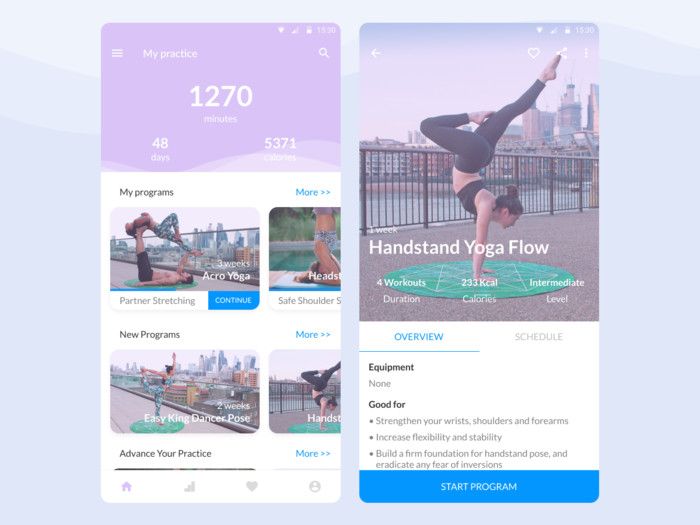
It's possible to arrange the Sessions Screen in many different ways (image by Justice Caring)
What is also great about the Yoga Sessions feature is that you can organize it in any convenient way. Here are a few ideas for your mobile application development for yoga instructor:
- Create curated collections to satisfy users with different needs.
- Offer guided yoga sessions classes that take place in real-time to support and help users during the whole session.
- Develop long-term workout plans (from several weeks and up to a month) in which different exercises are combined to reach a specific result.
# 3: Push Notifications 🔔
Finally, don’t forget about Push Notifications. There are plenty of ways to use them as you develop an app for yoga. For example:
- Encourage your clients to participate in your sessions regularly.
- Remind users about upcoming events.
- Inform the audience when new yoga exercise collections are available.
Push Notifications are a powerful retargeting tool, so we strongly recommend you to add it to your yoga app features MVP list.
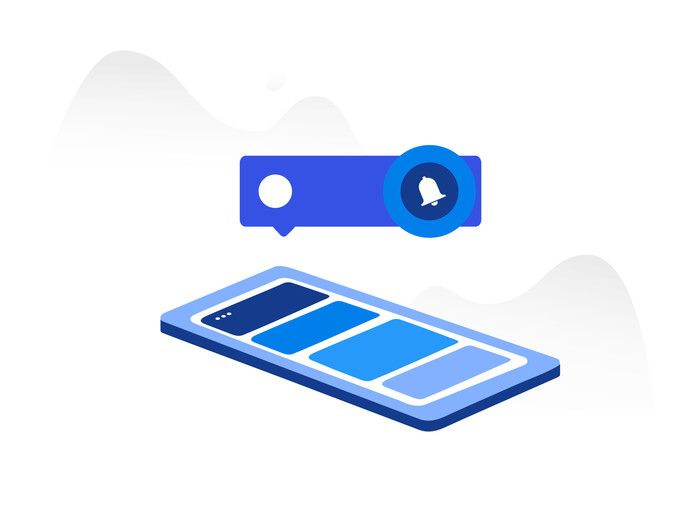
Push Notifications help to interact with existing users and return the old ones (image by akash chandra)
You can also use push notifications to send users reminders and take some moments to breathe deeply during the day and take a couple of mindfulness breaks to support their mental well-being. In case you’d like to learn more about building an application for mental health, feel free to follow the link:
# 4: eStore 🛍
The yoga app industry is much wider than just exercises and meditation courses. For example, people also need comfortable outfits, yoga mats, bags, towels, blocks and straps, meditation seatings, and so on.
So, although it’s not really an MVP-feature, if you’re selling some of these goods, it’s possible to create a yoga app that will also work as an online marketplace. According to some studies, mobile apps are even a better solution for retail purposes than a website since:
- Apps have a 120% higher conversion rate.
- People browse 286% more products using their mobile devices.
- The add-to-basket rate is also higher (up to 90%).
Therefore, you can greatly increase your key sales metrics.
# 5: Blog 📰
Usually, this feature doesn’t fit into the usual MVP list, so we’d recommend keeping it for the coming updates after your app gets a Proof of Concept. The good news is that it can be useful for both types of projects. Why?
Because people enjoy interesting and useful content. No matter if you plan to build your own yoga app with online yoga courses or an app for a yoga studio, your audience is likely to get more info on different techniques and methods, news, etc., through a blog.

Blog isn't a must-have feature but it provides additional value to your customers (image by Merve Guneyhan)
What is also great about the Blog Feature is that nowadays, people are open to share things they like. It means that they can repost your blog posts on their social media pages and become your brand promoters among friends and relatives.
This is also where the Social Media Login can come in handy. To make sure that users also benefit from connecting their media accounts to your app, you can offer them bonuses like discounts for paid content or unique avatars for their accounts.
# 6: Coach Q&A 💬
We see this feature as a part of your possible monetization strategy since it provides your audience with some advanced possibilities (this is especially true for Startups). Yet, if you’re designing app for yoga to complement your offline business, it may be reasonable to consider it free-of-charge and use it as a powerful tool to build a strong relationship between your studio and customers.
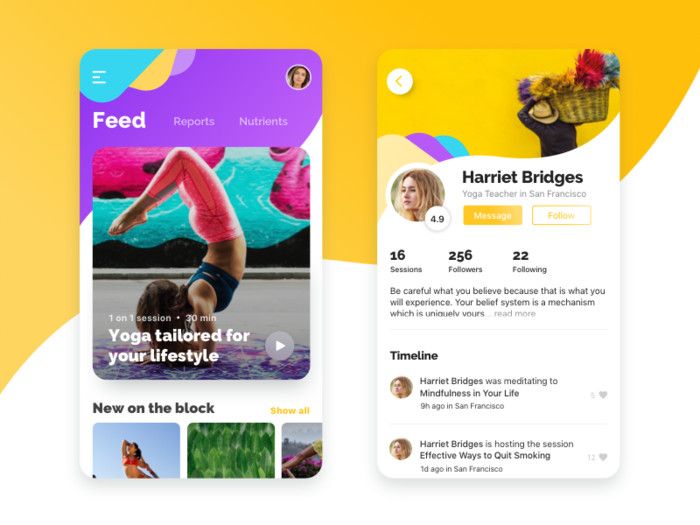
Many users expect the option to talk directly to yoga coaches, so provide them with it! (image by Andrei Ponivesc)
This feature can be a chat with a yoga coach who can help with exercise techniques or answer some organizational questions related to your studio.
You can also do it via the video sessions and surely would need a special features for that. It should be:
- Camera & audio functions.
- Turn on/off buttons.
- Chat within the call.
- Live reactions (like smiling or clapping emojis).
- Screen sharing (option) & others.
These functionalities are essential considerations in the context of yoga instructor app development.
# 7: Gamification 🏅
People love challenges. For you, this means that you can use challenges to keep users interested in frequent interactions with your brand. Providing the audience with a feeling of accomplishment is one of the best ways to keep your retention and engagement rates high.

Gamification (image by Trang Tran)
A great way to implement this feature is to reward users with badges as they get certain achievements (complete a course, workout a few days in a row, etc.).
# 8: Events 🏃♀️
If you regularly hold yoga training, chances are high you also organize some offline events like outdoor sessions, practices with invited yoga gurus, etc.
Therefore, you can make your own yoga app that will keep users informed about such activities. As a result, more people will know about your initiatives and join which means that your customer base will remain active and enthusiastic.
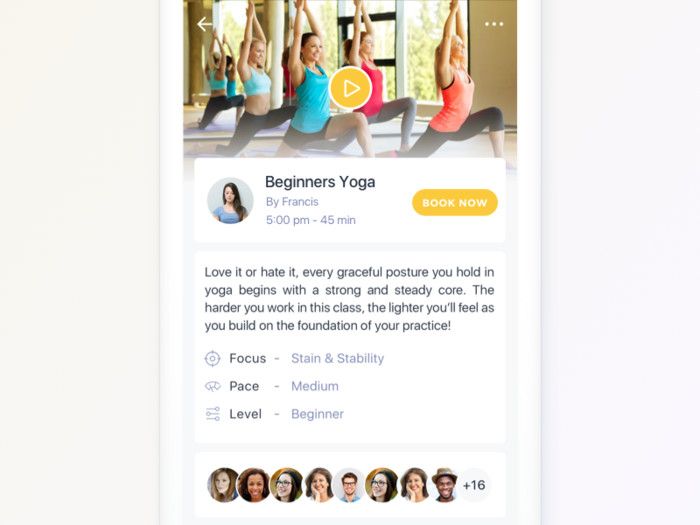
Yoga practitioners usually actively participate in different yoga-related events (image by Abhishek)
However, this feature may be also useful for Startups that want to build a strong community around their apps. Just like the Nike+ training — they have nothing to do with the official Nike representatives and are completely based on the enthusiasm of local users.
In conclusion, for a starting yoga instructor application to be successful, it should prioritize user-friendly registration processes, offer diverse and personalized yoga sessions, leverage push notifications for engagement, include an eStore for additional revenue streams, incorporate a blog for informative content and brand promotion, provide a coach Q&A feature for personalized guidance, implement gamification to enhance user engagement, and feature an events section to foster community involvement.
Balancing technical excellence with user experience will contribute to the app's overall success and appeal to a broad and accessible audience.
⚙️ Tech Stack For Yoga App Development
Here are some technical tools that your development partner can use to keep the good price-quality ratio and deliver your application on time while addressing the question of how to make a yoga app.
- Facebook Mobile SDKs can be helpful in many different ways: a fast sign-up process, analytics, monetization, providing customer support through Messenger, etc.
- If you want to create a yoga app with in-app payments, Stripe or Braintree SDKs are definitely some of the best options.
- Firebase SDK can be used in many ways. For example, you can implement a Push Notifications feature. Also, you can use the Firebase Console in your first stages to avoid building a separate Dashboard.
📝 Create a Yoga App in a Few Steps
In this section, we will provide detailed information on how to create a yoga app in the 7 key steps. Let's get started!
# 1 Market Research and Defining the Target Audience
Before starting the development of your yoga application, you need to analyze all yoga market trends, potential growth in the healthcare industry and make a competitor research. Define the target audience of your application in detail.
In addition to identifying the general group of people by age or gender, answer the main question: “Will the application be suitable for beginners, or are we targeting people who have been practicing yoga for a certain period?”
# 2 Concept, Features, and Monetization Strategy
The next step in yoga application development is to determine the app type: a specific studio app, an aggregator app, or a combination of both. Consider the key features (registration and login, various yoga sessions, personalized recommendations, high-quality video pose tutorials, social media integration, audio instructions, progress tracking, and multilingual support). Brainstorm with your team about additional features and think about what will make a yoga app stand out from others on the market.
Choose the ideal monetization options for your application. We will provide more details on this in the next section, so keep reading!

The meal plans feature can also be added to your yoga solutions.
(image by Vitalina Vykhrystiuk)
# 3 Tech Stack and Development Approach
This stage is crucial in the development process as it plays a significant role in your application's performance, scalability, and the security of user data. A cross-platform development approach, particularly in the expertise of fitness apps React Native development at Stormotion, can be a good solution.
If you are seeking experienced yoga app developers, write to us and share your idea, and we will gladly help you bring it to life.
In the era of artificial intelligence, we cannot overlook it. Integration with AI can help create personalized workout plans and engage users. The use of machine learning algorithms can assist in creating extra features such as pose analysis and progress forecasting, among others. This will significantly help distinguish your application in the market and attract users.
# 4 Design and User Experience
The application's design is the first thing users will see when they install it. Focus on a clean, intuitive interface with simple navigation. Use calm colors and straightforward menus to enhance user interaction.
# 5 Development and Testing
Design a yoga app gradually, starting with a Minimum Viable Product (MVP) to test core functionalities. MVP development has several advantages, such as releasing the app with basic features and quickly gathering valuable feedback from real users.
# 6 Launch and Marketing
Develop a strong marketing strategy with a focus on social media, content marketing, and partnerships with influencers. Launch a yoga app on relevant platforms (iOS and Android) and gather user reviews for improvement.

Extra features in your yoga application can also include a store for physical goods, such as premium-class yoga mats and accessories.
(image by erics)
# 7 Maintenance and Updates
The application is ready and released, but this is not the end. Regularly update the application, add new content, features, and fix any bugs. Monitor user reviews and analyze them to continually improve the application. In the future, you might want to expand the features of your app and offer fitness training with Bluetooth Low Energy (BLE) equipment. In that case, you should study how developers integrate BLE devices into fitness apps React Native.
By following all these steps you will be able to make your own yoga app like Asana Rebel.
💰 Yoga App Monetization Strategy
Now that we've covered how to start an app for online yoga, it's time to discuss monetization strategy. Here, we will take a detailed look at various methods that will help you not only develop a mobile app for yoga but also make it financially successful.
There are several ways to monetize your application. Let's examine each of them in more detail:
- Freemium Model: It’s the most used revenue strategy for yoga applications. Similar to Asana Rebel, these apps charge for premium content yet give out basic functions for free. With this approach, users may test out the app before deciding to sign up for a premium membership.
- In-app Purchases: With the app, users may purchase particular products or features like guided meditations, yoga courses, podcasts, or customized training regimens. Users who would rather pay just for what they actually need at that specific moment are catered to by this arrangement.
- Subscription Model: Users who want unrestricted access to a range of classes pay a regular price under the subscription model. With this arrangement, consumers may experiment with different yoga styles and teachers without having to commit to buying individual classes.
- Ads: Including advertisements is a typical approach for free apps. Without charging consumers directly, it makes money. However, excessive or bothersome advertising shouldn't detract from the user experience.
- Sponsorship and Affiliate Sales: Forming alliances with companies that are associated with yoga and wellness might prove to be profitable. This might entail signing direct sponsorship agreements or receiving payments via affiliate marketing.
- Paid Downloads: One-time download fees might work well for apps that cater to a certain niche or offer exclusive content.
Choosing a particular monetization model for a yoga application involves understanding your target audience, offering quality and personalized content, and taking into account the various preferences of users. By focusing on user experience and added value, yoga applications can effectively monetize, helping users achieve their health goals.
📚 Case Study: Pocket Yoga, Find What Feels Good
Before we finish, let’s review a few yoga app examples to see how the mentioned above theory meets practice.
Pocket Yoga & Pocket Yoga Teacher
This Startup is a perfect example of how you can connect instructors and learners by developing a yoga application.
The Pocket Yoga application application is designed for those who want to practice yoga.
The most remarkable features are:
- The exercise database includes over 200 illustrated poses (moreover, each goes with the voice instructions, description, and benefits).
- Users can choose practice sets created by professional teachers.
- Another idea you can reuse when developing a yoga application is letting users play music from their device’s library or other apps in place of the default music.
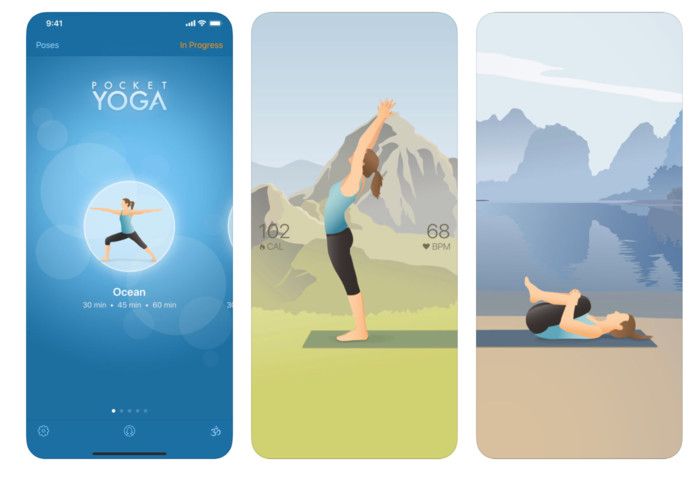
The Pocket Yoga App (image from AppStore)
However, there is even more than this! They’ve also delivered the Pocket Yoga Teacher app. As you can guess from its name, the application is designed yoga teachers. What are they able to do within the app?
- Create, edit and share yoga practice sets.
- The editing possibilities are quite broad: teachers are allowed to change the order and duration of poses, adjust the voiceover, add music, etc.
Their monetization model is paid downloads. They have two versions of the app - for practitioners and teachers that also differ in price.
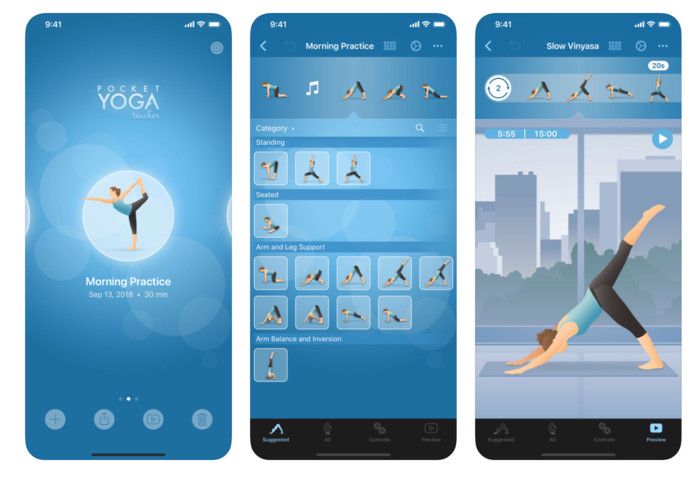
The Pocket Yoga Teacher App (image from AppStore)
Find What Feels Good (FWFG) Yoga with Adriene
The FWFG application is a great example of how you can build an app for a yoga studio or your own brand. Adriene is a yoga instructor, actress, and co-founder of this online yoga library. Her whole app is built around the idea of creating a strong and successful community that connects health experiences to real faces.
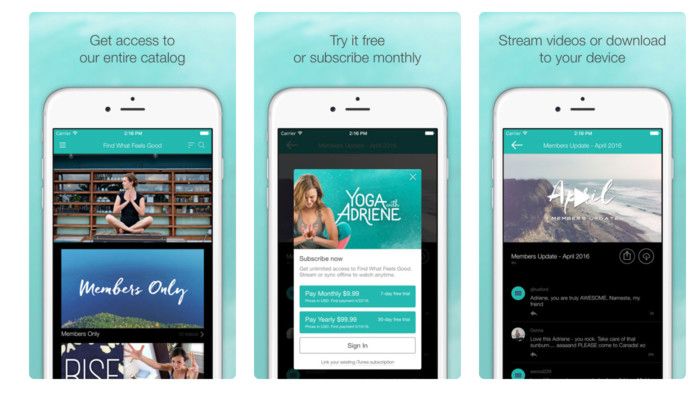
The FWFG Yoga with Adriene App (image from AppStore)
The monetization strategy is based on the subscription model: from $9.99 a month to $99.99 a year with a 7-30 days free trial period. For this money, people can access the following functionality:
- 100+ hours of HD videos.
- Possibility to download content for offline use.
- The comment section for community members to share their ideas and opinions.
- Social sharing.
As you can see, the set of features is quite basic. Yet, the app has an average rating of 5 stars (the best possible) based on 2200+ ratings.
💰 Cost to Make a Yoga App
Here is the estimate of costs to build a yoga application from the Stormotion Team:
Cost to Build a Yoga Mobile App
Using React Native
⚙️ Features/Development Stages | ⏳ Min Hours | ⏱ Max Hours |
🌍Project Discovery | 50 | 90 |
🎨UX/UI design | 30 | 55 |
🛠 Setup Technical Foundations | 6 | 10 |
👋 Onboarding | 8 | 12 |
🔐 Sign Up Flow | 44 | 54 |
Provide personal data | 14 | 18 |
Social sign up | 20 | 24 |
Forgot password | 10 | 12 |
👤 Profile Management Flow | 88 | 110 |
Workout calendar | 20 | 26 |
Workout history | 18 | 24 |
Dashboard | 50 | 60 |
🧘♀️ Yoga Sesions Flow | 54 | 66 |
Feed | 30 | 36 |
Video content | 24 | 30 |
Watch the video | 48 | 50 |
Save workout | 16 | 20 |
Saved workouts screen | 18 | 24 |
🔎 Search Flow | 42 | 52 |
Collections | 30 | 36 |
Filters | 12 | 16 |
🔔 Push Notifications | 24 | 30 |
👍 Extra features | 176 | 210 |
Blog | 54 | 60 |
Events Announcments | 12 | 16 |
eStore | 70 | 90 |
Chat with a coach | 40 | 50 |
CMS (Content Management System) Development | 110 | 140 |
🤓QA and Testing | 90 | 114 |
📱Release | 10 | 16 |
⏱Total Hours | 1218 | 1551 |
💵Approximate costs | $60,872 | $77,534 |
So, the yoga mobile app development costs are between $60-78,000.
We used an average hourly rate $50/hour that is quite standard for Eastern Europe.
If you want to get a more accurate estimate of costs to develop a yoga app, provide us with the details of your project by hitting the button at the end of the article.
💡 Takeaways
Yoga app development is a good idea for both Businesses and Startups operating in this industry:
- If you have your own studio, you can make a yoga app to build a stronger relationship with your customers and encourage them to interact more often with your brand.
- However, there are many yoga app examples that initially started as small startups and managed to grow into big products.
Looking for the perfect Tech Partner that will help you to create a Yoga App? Contact Stormotion by clicking the button below, and we, as an app development company, will revolutionize the yoga industry together!
Was it helpful?
Questions you may have
Take a look at how we solve challenges to meet project requirements
Have you worked with yoga studios or wellness businesses before?
We collaborated with clients in the HealthCare, Fitness & Sport sector, indicating their experience with fitness enthusiasts. Also, we developed solutions that could align well with the needs of yoga studios and wellness businesses.
What platforms and technologies do you specialize in (iOS, Android, IoT)?
Our company specializes in cross-platform application development ((although we have also dealt with the development of native apps), uses technologies like React Native, catering to both iOS and Android platforms. Our expertise extends to integrating with wearable devices and IoT, essential for yoga apps that might sync with fitness trackers and smartwatches.
Have you worked on apps integrating wearable fitness devices or IoT technology?
Yes, we have implemented solutions involving wearable devices based on BLE and Internet of Things (IoT) technology or even Smart TV. Our extensive experience in this field means that we can easily handle the development of a yoga application, integrating fitness trackers and smartwatches to enhance the monitoring of physical and mental health.
Can the app be customized to align with our yoga studio's branding and unique offerings?
Certainly, we can adapt the applications to your specific business goals, including customizing the app's user interface to align with your yoga studio's brand and offering unique features such as guided sessions, live broadcasts, or yoga class sequences.
What is your approach to app maintenance, updates, and bug fixes after the initial launch?
We offer ongoing maintenance and updates, ensuring that the application remains functional and up-to-date. Our development team is always available for bug fixes.
How do you ensure the app's scalability as our user base grows?
We, at Stormotion, focus on creating scalable web apps and mobile technology solutions, suggesting they use a specific technology stack and backend development strategies to handle increasing numbers of users, whether they are average yoga practitioners or more dedicated fitness enthusiasts.
Can you integrate reminders, progress tracking, and social sharing to keep users engaged?
Of course, we can integrate features like reminders, progress tracking, and social sharing, which are crucial for keeping users engaged in virtual yoga classes and workshops.
Do you have experience in app store optimization (ASO) to improve app discoverability?
Our experts can assist with increasing the visibility of your application on platforms such as Google Play and the Apple App Store.
Who will be part of the development team, and what are their roles and expertise?
The specific composition of the development team depends on the needs and scale of your project. Typically, it includes experienced designers and developers with expertise in both frontend and backend development, necessary for creating a comprehensive design for a yoga application, a project manager who will always be in communication with you (as our client), and a QA engineer.
Read also

How to Create a Fitness App: Process, Costs, Estimates and Challenges

What is Prototyping in IoT and Some Practical Advice

What is IoT Device Management?
Our clients say
![Stormotion client Pietro Saccomani, Founder from [object Object]](/static/40e913b6c17071a400d1a1c693a17319/b0e74/pietro.png)
They make the whole business work for us, and their improvements are fundamental to our operations. They’re reliable, honest, and willing to try new things that will help us. We appreciate how flexible and easygoing they are.
Pietro Saccomani, Founder
MobiLoud
